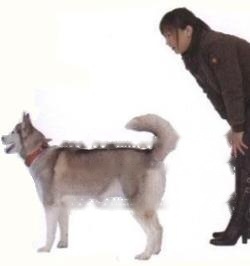Bronchiolitis is a chronic nonspecific inflammation of the trachea, bronchial mucosa and surrounding tissues. The main cause of bronchitis is chronic non-specific inflammation of the bronchi due to repeated infections by viruses and bacteria. When the temperature drops, the spasm and ischemia of the small blood vessels in the respiratory tract, and the defense function decline are conducive to pathogenesis; chronic stimuli such as smoke, dust, and air pollution can also cause the disease. Canine bronchopneumonia refers to the inflammation of individual lobules or several pulmonary lobules, so it is also called canine lobular pneumonia. Dog bronchopneumonia is not difficult to treat. As long as you pay attention to daily care and use the correct medication, the general cure rate can reach more than 95%.
 PoodleDog
PoodleDogI. Symptoms of bronchitis in dogs
Clinically above, the main features were flaccid fever, increased breathing frequency, cough, and localized pneumonia in the lungs. Canine bronchopneumonia is inflammation of the bronchi and/or bronchioles and pulmonary lobules caused by colds, physical and chemical factors, and certain infectious and parasitic diseases. Usually, the alveoli are filled with catarrhal exudates composed of epithelial cells, plasma and leukocytes, so it is also called catarrhal pneumonia. There are scattered focal areas of dullness on percussion and crepitus on auscultation. Puppies and aged dogs are more affected, with the highest incidence in late autumn, winter and early spring.
Laboratory examination showed that due to the similar symptoms of canine distemper and canine parainfluenza in the early and middle stages, the rapid detection of CDV and CPIV colloidal gold was performed, and the results were all negative. Routine blood examination found that the total number of white blood cells and neutrophils were increased, and the phenomenon of nuclear left shift appeared. X-ray examination revealed increased lung markings with small patchy shadows.
2. Treatment of dog bronchopneumonia
Dog bronchopneumonia is more likely to be compared with dog cold, panbronchitis, canine distemper, canine lobe Sexual pneumonia is confused, so it should be diagnosed before the treatment of canine bronchopneumonia, and then the right medicine can be treated. So how should canine bronchopneumonia be treated?
The principles of treatment include strengthening nursing, improving nutrition, antibacterial and anti-inflammatory, antitussive and expectorant, preventing exudation and promoting absorption of exudates, and symptomatic treatment. One is antibacterial and anti-inflammatory. Subcutaneous injection: ①0.9% normal saline + levofloxacin injection 7mL; ②Pulmonary double antibody + ribavirin 25mg; ③Dexamethasone sodium phosphate 1mg, once a day, for 3 days. The second is to prevent seepage. Intravenous injection: 20 mL of 10% glucose + 2 mL of 10% calcium gluconate, once a day, for 3 days. The third is antitussive and expectorant. Oral: Compound Licorice Mixture 1mL, 3 times/d. The fourth is symptomatic treatment. To reduce fever, intramuscular injection of Antondin 0.5mL, or oral nimesulide 5mg, body temperature not higher than 39.5 ℃ do not use. Fifth, strengthen nursing. Reduce the exercise of sick dogs, feed dog food, eat less and more meals, and supplement with powerful multi-dimensional nutrition cream, immune polysaccharide cream, etc. to improve the body's immunity and promote recovery.
3. Precautions for bronchopneumonia in dogs
The treatment of bronchopneumonia in dogs is not very difficult, mainly due to cold, physical and chemical factors However, in the process of treating and caring for canine bronchopneumonia, there are still six precautions that need to be paid attention to.
1. Early diagnosis is the key to the treatment of canine bronchopneumonia. If not diagnosed and treated in time, it can lead to aggravation of the disease and even death in severe cases. Controlling and eliminating inflammation is the fundamental measure for the treatment of lobular pneumonia, which should be carried out throughout the entire treatment process. The choice of antibiotics is the key to the treatment of pulmonary infection in dogs. In most cases, the pathogen cannot be identified. Therefore, when choosing antibiotics, both cocci and bacilli should be taken into consideration, and an effective empirical therapy should be established comprehensively. Conditional drug susceptibility testing can be done, and sensitive antibiotics can be selected.
2. According to clinical observation, in the case of severe inflammation, animals may often enter a state of shock. A large number of treatment practices have proved that shock is the main cause of death in canine bronchitis cases. When dyspnea occurs or hypoxemia is suspected, if possible, oxygen should be inhaled as soon as possible (with an oxygen concentration of 30%).
3. Symptomatic treatment. For high fever, Antonidine or Nimesulide can be used; if chest pain is severe, codeine syrup can be used orally; for cough, codeine or Kebiqing can be used; expectoration, Runjin, Mucosolvan, Ammonium Chloride Mixture, Acetyl Cysteine or chymotrypsin, etc.; to maintain water and electrolyte balance, oral rehydration salts or infusion can be used (to control the infusion rate and total amount of fluid); aerosol therapy (early use), the formula is antibiotics, chymotrypsin, glucocorticoids, etc. , add normal saline to 10 ~ 100mL; sedative and stop cough, licorice, cough syrup, etc. can be used; early use of glucocorticoids can prevent heart and renal insufficiency and respiratory failure.
4. After the symptoms are stabilized, the pulmonary respiratory function will be weakened, and there is still the possibility of repeated attacks in the short term. Strenuous exercise is prohibited, keep warm.
5. The sick dog should be re-examined, and another chest X-ray can be performed at certain intervals to monitor the recovery of the lungs and determine whether complications may occur.
6. The kennel and environment should be disinfected regularly. Disinfection is a key measure to cut off the spread of respiratory infectious diseases.
![[Dog Training 5] The training method of pet dog dining etiquette](/static/img/12192/12192_1.jpg)




